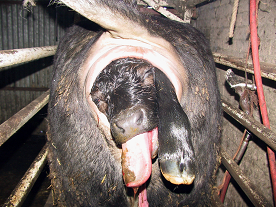

The embryo develops in the uterine horns. The body of the uterus is relatively short and poorly developed, while the uterine horns are longer and well developed. If it is fertilized, it begins embryological development in the uterus. The egg moves through the oviduct and into the uterus within the next three to four days. Thus, it is very important that fertile sperm be present near the time of ovulation. The egg remains capable of fertilization for only a few hours. The released egg is caught by the infundibulum and moves into the oviduct, where fertilization occurs if viable sperm are present. At ovulation, the thin portion ruptures to release the contents of the follicle, including the egg.įollowing ovulation, the cells that developed within the follicle differentiate to form the corpus luteum, which has the important function of producing progesterone. Once the follicle reaches this mature state it is called a Graafian follicle. As the follicle continues to grow rapidly, the side opposite the egg bulges from the surface of the ovary and becomes very thin. As the follicle and cavity grow larger, the egg becomes attached to the back of the follicle (opposite the ovulation site) by a stalk of cells. Many layers of cells are added to the single layer of cells surrounding the egg in the primary follicle, forming a central cavity.
Cow vag series#
The relatively few primary follicles that develop completely do so through a series of phases. Rather, they die, are absorbed by the ovary, and are replaced by newly formed primary follicles. However, most of the primary follicles never develop. This germ cell has the potential to mature into an egg if the follicle completes development. Each follicle consists of a germ cell surrounded by a layer of cells. The ovary contains several thousand tiny structures called primary follicles. This cycle (called the estrous cycle) has a characteristic length and consists of a definite sequence of events, both physiological and behavioral. In contrast to the continuous production of sperm (spermatogenesis) in the male, oogenesis is cyclic. The ovary produces the egg by a process called oogenesis. Diagram of the reproductive tract of the cow. Figure 1 presents a diagram of the complete reproductive tract anatomy.įigure 1. These organs include the vagina, cervix, uterus, uterine horns, and oviducts (also called Fallopian tubes), which each have a funnel-shaped opening called the infundibulum. The secondary sex organs are a series of tubes that receive semen, transport sperm to the egg so it can be fertilized, nourish the fertilized egg (embryo), and allow the calf to be birthed. The cow's two ovaries are oval to bean-shaped organs that are 1-1.5 inches long and located in the abdominal cavity. The ovary is the primary female reproductive organ and has two important functions: producing the female reproductive cell (the egg or ovum) and producing the hormones estrogen and progesterone. It will also enable producers to better understand and control reproductive diseases and calving problems. Basic knowledge in this area will help producers do a better job of getting cows rebred, especially when using artificial insemination and estrus synchronization. Understanding the anatomy and physiology of the cow's reproductive system is fundamental to good cattle management. Send us feedback.Reproductive Tract Anatomy and Physiology of the CowĬollege of Agricultural, Consumer and Environmental SciencesĪuthor: Professor/Extension Horse Specialist, Department of Extension Animal Sciences and Natural Resources, New Mexico State University ( Print-friendly PDF) Introduction These example sentences are selected automatically from various online news sources to reflect current usage of the word 'vaginosis.' Views expressed in the examples do not represent the opinion of Merriam-Webster or its editors. Lauran Neergaard, The Seattle Times, 1 June 2017 Others harbored less healthy species that lead to bacterial vaginosis, inflammation that can increase risk of certain health problems. 2017 Others harbored less healthy species that lead to bacterial vaginosis, inflammation that can increase risk of certain health problems. Zoe Ferguson,, 13 July 2017 Currently our lead product is in a Phase II clinical stage to demonstrate the safety and effectiveness in treating bacterial vaginosis. 2020 Bacterial vaginosis is a common condition triggered by an overgrowth of normal vaginal bacteria. 2020 If a woman is infected during a pregnancy, vaginosis can cause the baby to be born prematurely or with a low birth weight. Recent Examples on the Web Unlike a bacterial infection like vaginosis, yeast infections do not make discharge smelly.Īmy Marturana Winderl, SELF, 6 Oct.


 0 kommentar(er)
0 kommentar(er)
